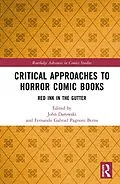This volume explores how horror comic books have negotiated with the social and cultural anxieties framing a specific era and geographical space.
Paying attention to academic gaps in comics' scholarship, these chapters engage with the study of comics from varying interdisciplinary perspectives, such as Marxism; posthumanism; and theories of adaptation, sociology, existentialism, and psychology. Without neglecting the classical era, the book presents case studies ranging from the mainstream comics to the independents, simultaneously offering new critical insights on zones of vacancy within the study of horror comic books while examining a global selection of horror comics from countries such as India (City of Sorrows), France (Zombillénium), Spain (Creepy), Italy (Dylan Dog), and Japan (Tanabe Gou's Manga Adaptations of H.P. Lovecraft), as well as the United States.
One of the first books centered exclusively on close readings of an under-studied field, this collection will have an appeal to scholars and students of horror comics studies, visual rhetoric, philosophy, sociology, media studies, pop culture, and film studies. It will also appeal to anyone interested in comic books in general and to those interested in investigating intricacies of the horror genre.
Autorentext
John Darowski is a PhD candidate in Comparative Humanities at the University of Louisville, USA. He has edited an essay collection on Superman adaptations (2021) and has published several essays on the history of superheroes.
Fernando Gabriel Pagnoni Berns (PhD) works at the Universidad de Buenos Aires (UBA), Argentina. He teaches courses on international horror film and has authored a book about Spanish horror TV series Historias para no Dormir (2019) and has edited a book on James Wan's films.
Inhalt
1. Introduction John Darowski and Fernando Gabriel Pagnoni Berns
Part I: Horror Comic Books in a Socio-Historical Context
2. From Caligari to Wertham: When EC's Horror Comics Feared for Their Own Survival Rui Lopes
3. "Men have Sentenced this Fen to Death:" Marvel's Man-Thing and the Liberation Politics of the 1970s Henry Kamerling
4. The Horrors Haunting the City of Joy: Analyzing the Traumas of the Counterinsurgency in City of Sorrows Debaditya Mukhopadhyay
5. Spanish Creepy: Historical Amnesia in "Las mil caras de Jack el destripador" Fernando Gabriel Pagnoni Berns
Part II: Race and Gender in Horror Comic Books
6. "A sight to dream of, not to tell!": Orality and Power in Marguerite Bennett and Ariela Kristantina's InSEXts Lauren Chochinov
7. Gendered Violence and the Abject Body in Junji Ito's Tomie Tosha Taylor
8. Lily Renée's "The Werewolf Hunter" and the Secret Origin of Horror Comics Blair Davis
9. The Wolf Only Needs to Find You Once: Food, Feeding, and Fear in the Dark Fairy Tales of Emily Carroll Alexandre Desbiens-Brassard and Gabriella Colombo Machado
10. Borderland Werewolves: The Horrific Representation of the US-Mexico Border in Feeding Ground Anna Marta Marini
Part III: Adaptation in Horror Comic Books
11. Flesh and Blood: Zombies, Vampires, and George A. Romero's Transmedia Expansion of the Dead Trevor Snyder
12. An Alien World: A Comic Book Adaptation of The Willows by Algernon Blackwood Yelena Novitskaya
13. Horror Transformed: Tanabe Gou's Manga Adaptations of H.P. Lovecraft Andrew Smith
14. Mutant Gothic: Marvel's Mainstreaming of Horror in Uncanny X-Men Joseph Darowski
15. Franken-Castle: Monster Hunters, Monstrous Masculinities, and the Punisher John Darowski
Part IV: Horror Comic Books and Philosophy
16. Dylan Dog's Nightmares: The Unheimlich Experience of the Doppelgänger in Dylan Dog's World Marco Favaro
17. Messages of Death: Haunted Media in "Kaine: Endorphins-Between Life and Death" Ingrid Butler
18. Heterotopia & Horror at Show's End Christina M. Knopf
19. The Hell Economics of Zombillénium Annick Pellegrin
Index
